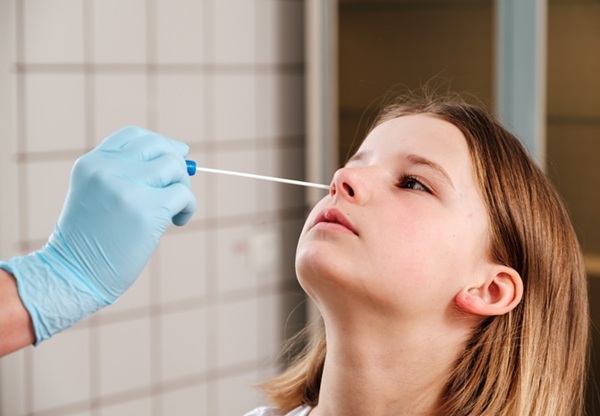Rapid Nasal Swab Test Detects Asthma Type in Kids
|
By HospiMedica International staff writers Posted on 06 Jan 2025 |

Asthma is the most prevalent chronic condition in children, with a particularly high impact on Black and Puerto Rican children. It is crucial to develop new therapies to address the specific needs of these young patients. Traditionally, asthma has been categorized into endotypes: T2-high or T2-low, based on the levels of T helper 2 (T2) inflammation. More recently, the T2-low category has been further divided into two distinct subtypes: T17-high, characterized by increased T helper 17 (T17) inflammation and low T2 inflammation, and low-low, marked by low levels of both T2 and T17 inflammation. Given the variability of asthma, which is driven by different immune cells and responds to treatments in diverse ways, the first step toward improving therapies is accurate endotype diagnosis. Traditionally, diagnosing endotype involves a genetic analysis of lung tissue obtained through a bronchoscopy, a procedure performed under general anesthesia. However, for children, particularly those with milder asthma, this invasive approach is often impractical and unethical. As a result, clinicians have had to rely on less accurate tools, such as immune markers in the blood, lung function tests, and allergy presence.
Now, researchers at the University of Pittsburgh (Pittsburgh, PA, USA) have developed a non-invasive nasal swab test for children to diagnose specific asthma subtypes or endotypes. This approach promises to enable clinicians to prescribe treatments more precisely and could pave the way for research into therapies for less-studied asthma types that have been difficult to diagnose accurately. The study, published in JAMA, analyzed data from three independent U.S.-based studies, focusing on Puerto Rican and African American youth, who experience higher asthma rates and mortality compared to non-Hispanic white children.
The researchers collected nasal samples from 459 children across the three studies and analyzed the expression of eight T2 and T17 signature genes. As anticipated, the nasal swab analysis revealed the asthma endotype for each patient. Across the studies, 23% to 29% of participants were classified as T2-high, 35% to 47% as T17-high, and 30% to 38% as low-low endotype. While biologic drugs that target immune cells driving T2-high asthma are available, there are no current biologic treatments for T17-high and low-low endotypes. With the availability of this simple nasal swab test to detect other endotypes, the focus can now shift on developing biologics for T17-high and low-low disease. This rapid diagnostic test could also accelerate progress in other areas of asthma research.
“One of the million-dollar questions in asthma is why some kids get worse as they enter puberty, some stay the same and others get better. Before puberty, asthma is more common in boys, but the incidence of asthma goes up in females in adulthood,” said senior author Juan Celedón, M.D., Dr. P.H., professor of pediatrics at Pitt. “Is this related to endotype? Does endotype change over time or in response to treatments? We don’t know. But now that we can easily measure endotype, we can start to answer these questions.”
Channels
Critical Care
view channel
AI-Powered, Internet-Connected Medical Devices to Revolutionize Healthcare, Finds Study
A new study suggests that artificial intelligence (AI)-powered, internet-connected medical devices have the potential to transform healthcare by enabling earlier detection of diseases, real-time patient... Read more
Starfish-Inspired Wearable Tech Enables Smarter Heart Monitoring
Physical movement can make it challenging for current wearable devices to accurately track heart activity. Now, a starfish’s five-arm shape has helped resolve this issue. Inspired by the starfish's ability... Read moreSurgical Techniques
view channel
New Transcatheter Valve Found Safe and Effective for Treating Aortic Regurgitation
Aortic regurgitation is a condition in which the aortic valve does not close properly, allowing blood to flow backward into the left ventricle. This results in decreased blood flow from the heart to the... Read more
Minimally Invasive Valve Repair Reduces Hospitalizations in Severe Tricuspid Regurgitation Patients
The tricuspid valve is one of the four heart valves, responsible for regulating blood flow from the right atrium (the heart's upper-right chamber) to the right ventricle (the lower-right chamber).... Read morePatient Care
view channel
Portable Biosensor Platform to Reduce Hospital-Acquired Infections
Approximately 4 million patients in the European Union acquire healthcare-associated infections (HAIs) or nosocomial infections each year, with around 37,000 deaths directly resulting from these infections,... Read moreFirst-Of-Its-Kind Portable Germicidal Light Technology Disinfects High-Touch Clinical Surfaces in Seconds
Reducing healthcare-acquired infections (HAIs) remains a pressing issue within global healthcare systems. In the United States alone, 1.7 million patients contract HAIs annually, leading to approximately... Read more
Surgical Capacity Optimization Solution Helps Hospitals Boost OR Utilization
An innovative solution has the capability to transform surgical capacity utilization by targeting the root cause of surgical block time inefficiencies. Fujitsu Limited’s (Tokyo, Japan) Surgical Capacity... Read more
Game-Changing Innovation in Surgical Instrument Sterilization Significantly Improves OR Throughput
A groundbreaking innovation enables hospitals to significantly improve instrument processing time and throughput in operating rooms (ORs) and sterile processing departments. Turbett Surgical, Inc.... Read moreHealth IT
view channel
Printable Molecule-Selective Nanoparticles Enable Mass Production of Wearable Biosensors
The future of medicine is likely to focus on the personalization of healthcare—understanding exactly what an individual requires and delivering the appropriate combination of nutrients, metabolites, and... Read more
Smartwatches Could Detect Congestive Heart Failure
Diagnosing congestive heart failure (CHF) typically requires expensive and time-consuming imaging techniques like echocardiography, also known as cardiac ultrasound. Previously, detecting CHF by analyzing... Read morePoint of Care
view channel
Handheld, Sound-Based Diagnostic System Delivers Bedside Blood Test Results in An Hour
Patients who go to a doctor for a blood test often have to contend with a needle and syringe, followed by a long wait—sometimes hours or even days—for lab results. Scientists have been working hard to... Read more
Smartphone-Enabled, Paper-Based Quantitative Diagnostic Platform Transforms POC Testing
Point-of-care diagnostics are crucial for public health, offering rapid, on-site testing that enables prompt diagnosis and treatment. This is especially valuable in remote or underserved regions where... Read moreBusiness
view channel
Expanded Collaboration to Transform OR Technology Through AI and Automation
The expansion of an existing collaboration between three leading companies aims to develop artificial intelligence (AI)-driven solutions for smart operating rooms with sophisticated monitoring and automation.... Read more




















